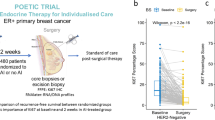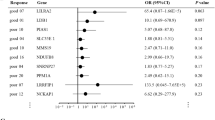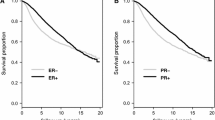Abstract
Aromatase inhibition (AI) is the most effective endocrine treatment for breast cancer in post-menopausal patients, but a percentage of hormone receptor-positive cancers do not benefit from such therapy: for example, about 20% of patients treated with anastrozole do not respond and it is still impossible to accurately predict sensitivity. Our main goal was to identify a robust expression signature predictive of response to neoadjuvant treatment with anastrozole in patients with ER+ breast cancer. At the same time, we addressed the question of delineating treatment effects and possible mechanisms of intrinsic resistance occurring in non-responder patients. We analyzed the transcriptome of 17 tru-cut biopsies before treatment and 13 matched surgical samples after 3 months treatment with anastrozole taken from ER+ breast tumors. Molecular profiles were related to clinical response data. Treatment with anastrozole was associated with a decreased expression of genes relating to cell proliferation and an increased expression of genes relating to inflammatory processes. There was also an enrichment of induction of T-cell anergy, positive regulation of androgen signalling, synaptic transmission and vesicle trafficking in non-responders, and of cell cycle inhibition and induction of immune response in responders. We identified an expression signature of 77 probes (54 genes) that predicted response in 100% of our cases. Five of them were able to accurately predict response on an independent dataset (P = 0.0056) of 52 ER+ breast cancers treated with letrozole. Ten fixed independent samples from the anastrozole study were also used for RT-qPCR validations. This study suggests that a relative small number of genes analysed in a pre-treatment biopsy may identify patients likely to respond to AI neoadjuvant treatment. This may have practical utility translatable to the clinics. Furthermore, it delineates novel mechanisms of intrinsic resistance to AI therapy that could be further investigated in order to explore circumventing treatments.





Similar content being viewed by others
References
Hortobagyi GN (1998) Treatment of breast cancer. N Engl J Med 339:974–984
Early Breast Cancer Trialists’ Collaborative Group (1998) Tamoxifen for early breast cancer: an overview of the randomised trials. Lancet 351:1451–1467
Mauriac L, Smith I (2003) Aromatase inhibitors in early breast cancer treatment. Semin Oncol 4(Suppl 14):46–57
Mouridsen H, Gershanovich M, Sun Y, Pérez-Carrión R, Boni C et al (2001) Superior efficacy of letrozole versus tamoxifen as first-line therapy for postmenopausal women with advanced breast cancer: results of a phase III study of the International Letrozole Breast Cancer Group. J Clin Oncol 19:2596–2606
Goss PE, Ingle JN, Martino S, Robert NJ, Muss HB et al (2003) A randomized trial of letrozole in postmenopausal women after five years of tamoxifen therapy for early-stage breast cancer. N Eng J Med 349:1793–1802
Coombes RC, Hall E, Gibson LJ, Paridaens R, Jassem J et al (2004) A randomized trial of exemestane after two to three years of tamoxifen therapy in postmenopausal women with primary breast cancer. N Engl J Med 350:1081–1092
Harada N (1997) Aberrant expression of aromatase in breast cancer tissues. J Steroid Biochem Mol Biol 61:175–184
Sun XZ, Zhou D, Chen S (1997) Autocrine and paracrine actions of breast tumor aromatase. A three-dimensional cell culture study involving aromatase transfected MCF-7 and T-47D cells. J Steroid Biochem Mol Biol 63:29–36
Miller WR, Dixon JM, Macfarlane L, Cameron D, Anderson TJ (2003) Pathological features of breast cancer response following neoadjuvant treatment with either letrozole or tamoxifen. Eur J Cancer 39:462–468
Anderson TJ, Dixon JM, Stuart M, Sahmoud T, Miller WR (2002) Effect of neoadjuvant treatment with Anastrozole on tumour histology in postmenopausal women with large operable breast cancer. Br J Cancer 87:334–338
Milla Santos A, Milla l, Calvo N, Portella J, Rallo L et al (2004) Anastrozole as neoadjuvant therapy for patients with hormone-dependent, locally-advanced breast cancer. Anticancer Res 24:1315–1318
Kristensen VN, Sørlie T, Geisler J, Yoshimura N, Linegjaerde OC et al (2005) Effects of Anastrozole on the intratumoral gene expression in locally advanced breast cancer. J Steroid Biochem Mol Biol 95:105–111
Harvell DM, Richer JK, Singh M, Spoelstra N, Finlayson C et al (2008) Estrogen regulated gene expression in response to neoadjuvant endocrine therapy of breast cancer: tamoxifene agonist effects dominate in the presence of an aromatase inhibitor. Breast Cancer Res Treat 112:489–501
Miller WR, Larionov A, Renshaw L, Anderson TJ, Walker JR et al (2009) Gene expression profiles differentiating between breast cancers clinically responsive or resistant to letrozole. J Clin Oncol 27:1382–1387
Therasse P, Arbuck SG, Eisenhauer EA, Wanders J, Kaplan RS et al (2000) New guidelines to evaluate the response to treatment in solid tumors. European Organization for Research and Treatment of Cancer, National Cancer Institute of the United States, National Cancer Institute of Canada. J Natl Cancer Inst 92:205–216
Deaglio S, Vaisitti T, Aydin S, Bergui L, D’Arena G et al (2007) CD38 and ZAP-70 are functionally linked and mark CLL cells with high migratory potential. Blood 110:4012–4021
Smyth GK (2004) Linear models and empirical bayes methods for assessing differential expression in microarray experiments. Stat Appl Genet Mol Biol 3: Article 3
Miller WR, Larionov A, Renshaw L, Anderson TJ, White S et al (2007) Aromatase inhibitors-gene discovery. J Steroid Biochem Mol Biol 106:130–142
Scatolini M, Mello Grand M, Grosso E, Venesio T, Pisacane A et al (2010) Altered molecular pathways in melanocytic lesions. Int J Cancer 126:1869–1881
Ochsner SA, Steffen DL, Hilsenbeck SG, Chen ES, Watkins C, McKenna NJ (2009) GEMS (Gene Expression MetaSignatures), a Web resource for querying meta-analysis of expression microarray datasets: 17beta-estradiol in MCF-7 cells. Cancer Res 69:23–26
Itoh T, Karlsberg K, Kijima I, Yuan YC, Smith D et al (2005) Letrozole-, Anastrozole-, and tamoxifen-responsive genes in MCF-7aro cells: a microarray approach. Mol Cancer Res 3:203–218
Hayashi S, Yamaguchi Y (2008) Estrogen signaling in cancer microenvironment and prediction of response to hormonal therapy. J Steroid Biochem Mol Biol 109:201–206
Williams C, Edvardsson K, Lewandowski SA, Ström A, Gustafsson JA (2008) A genome-wide study of the repressive effects of estrogen receptor beta on estrogen receptor alpha signaling in breast cancer cells. Oncogene 27:1019–1032
Sismondi P, Biglia N, Ponzone R, Fuso L, Scafoglio C et al (2007) Influence of estrogens and antiestrogens on the expression of selected hormone-responsive genes. Maturitas 57:50–55
Wilson CL, Sims AH, Howell A, Miller CJ, Clarke RB (2006) Effects of oestrogen on gene expression in epithelium and stroma of normal human breast tissue. Endocr Relat Cancer 13:617–628
Cappelletti V, Gariboldi M, De Cecco L, Toffanin S, Reid JF et al (2008) Patterns and changes in gene expression following neo-adjuvant anti-estrogen treatment in estrogen receptor-positive breast cancer. Endocr Relat Cancer 15:439–449
Mackay A, Urruticoechea A, Dixon JM, Dexter T, Fenwick K et al (2007) Molecular response to aromatase inhibitor treatment in primary breast cancer. Breast Cancer Res 9:R37
Wang J, Zhang Q, Jin S, Feng M, Kang X et al (2009) Immoderate inhibition of estrogen by anastrozole enhances the severity of experimental polyarthritis. Exp Gerontol 44:398–405
Lin HY, Sun M, Lin C, Tang HY, London D et al (2009) Androgen-induced human breast cancer cell proliferation is mediated by discrete mechanisms in estrogen receptor-alpha-positive and -negative breast cancer cells. J Steroid Biochem Mol Biol 113:182–188
Sikora MJ, Cordero KE, Larios JM, Johnson MD, Lippman ME et al (2009) The androgen metabolite 5alpha-androstane-3beta, 17beta-diol (3betaAdiol) induces breast cancer growth via estrogen receptor: implications for aromatase inhibitor resistance. Breast Cancer Res Treat 115:289–296
Español AJ, de la Torre E, Fiszman GL, Sales ME (2007) Role of non-neuronal cholinergic system in breast cancer progression. Life Sci 80:2281–2285
Jones MC, Caswell PT, Norman JC (2006) Endocytic recycling pathways: emerging regulators of cell migration. Curr Opin Cell Biol 18:549–557
Stein MP, Dong J, Wandinger-Ness A (2003) Rab proteins and endocytic trafficking: potential targets for therapeutic intervention. Adv Drug Deliv Rev 55:1421–1437
Bièche I, Chavey C, Andrieu C, Busson M, Vacher S et al (2007) CXC chemokines located in the 4q21 region are up-regulated in breast cancer. Endocr Relat Cancer 14:1039–1052
Acknowledgements
We thank Dr Annalisa Lanza, from Fondazione Maugeri, for sample storing and delivery and Prof Paolo Provero (Molecular Biotechnology Centre, University of Torino) for his supervision on data analysis. The study was partially supported by an educational grant from Astra Zeneca, who had no role in study design, data collection or interpretation, or manuscript submission, for which the authors had full responsibility.
Author information
Authors and Affiliations
Corresponding author
Additional information
Maurizia Mello-Grand and Vijay Singh contributed equally to the work.
Electronic supplementary material
Below is the link to the electronic supplementary material.
Supplementary Figure 1
Heat map diagram of difference matrix (D) prepared using 1280 differentially expressed probes. R=responders, N=non-responders (PDF 41 kb)
Supplementary Figure 2
RT-qPCR results. Relative expression value box-plots of four response correlated genes (CXCL3, GSS, FBXL18 and DUSP1), using the average of RPLP0 and TBP as reference, for non-responders (white boxes) and responders (grey boxes) (PDF 1187 kb)
Rights and permissions
About this article
Cite this article
Mello-Grand, M., Singh, V., Ghimenti, C. et al. Gene expression profiling and prediction of response to hormonal neoadjuvant treatment with anastrozole in surgically resectable breast cancer. Breast Cancer Res Treat 121, 399–411 (2010). https://doi.org/10.1007/s10549-010-0887-y
Received:
Accepted:
Published:
Issue Date:
DOI: https://doi.org/10.1007/s10549-010-0887-y




